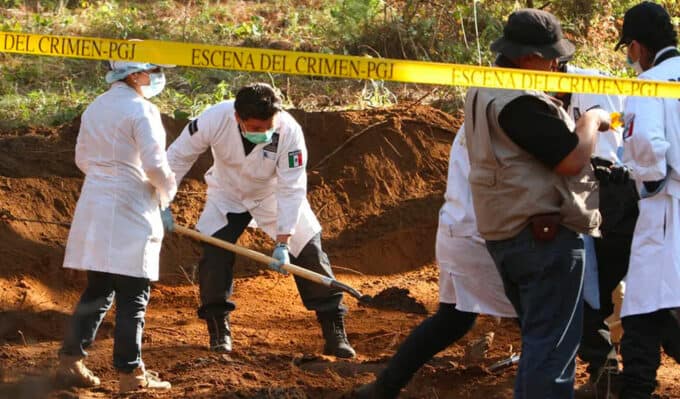Families combing for clues about their vanished loved ones at recently discovered extermination sites in northern Mexico have turned to local cartel leaders for help — revealing their desperation to find any trace of the disappeared amid masses of incinerated bones.
At the end of July, families of those missing in Tamaulipas issued a letter to the Gulf Cartel faction operating in Matamoros, along the U.S.-Mexico border.
“We are not looking for culprits; We are looking for our sons, daughters, fathers, mothers, brothers, sisters and relatives,” they insisted.
Earlier that month, the Mexican government recognized the existence of an extermination site in Matamoros, where more than half a ton of skeletal remains have been found. The location, known as La Bartolina, lies just 12 kilometers from the border at Brownsville, Texas.
In Tamaulipas alone, groups searching for the disappeared have identified 57 such extermination sites since the end of 2012, according to a report from news portal Elefante Blanco.
Just days before the letter from the families in Tamaulipas, the United Forces for Our Disappeared in Nuevo León (Fundenl) issued a press release urging authorities in the northern border state to speed up investigations into five such sites, where more than 600,000 skeletal remains have been recovered since 2010.
The graves classed as extermination sites all share certain macabre characteristics: multiple clandestine graves, containers to incinerate bodies, encampments, confinement areas and victims’ remains.
In an interview with Elefante Blanco, Mexico’s national search commissioner, Karla Quintana Osuna, stated that La Bartolina is the largest extermination site that federal authorities have identified.
“We have decided to designate them ‘extermination sites’ … because they are crematoriums where they have tried to disappear and pulverize at least hundreds of people,” Quintana said in an interview with Milenio.
Over the last 15 years, more than 80,000 people have disappeared in Mexico. According to a report by the federal government in April, Tamaulipas and Nuevo León are among the five states with the highest number of disappearances reported.
InSight Crime analysis
Recognizing the existence of extermination sites in Mexico is an important step toward understanding the magnitude of the country’s crisis of forced disappearances. However, there is still a long way to go to address the systematic human rights violations that have occurred in the country’s northeast, where criminal groups remain in power.
The areas where extermination centers have been detected once had a significant presence of the Zetas and the Gulf Cartel. These drug groups were involved in several episodes of extreme violence that claimed the lives of thousands of victims.
For example, the Piedras Negras prison in Coahuila was used as an extermination center where the Zetas murdered more than 150 people between 2010 and 2012. Their bodies were then burned in diesel-filled barrels known as “ovens.” Police and prison personnel were aware that the prison was being used as a death camp.
Previously considered some of the most violent groups in Mexico, the Zetas and the Gulf Cartel no longer wield the same power after fracturing. Splinter groups, though, continue to terrorize locals. For example, in June, shootouts in Reynosa left 26 people dead, many of whom were said to be bystanders. A cell linked to the Gulf Cartel was blamed for the gunfire, as well as for the kidnapping of 119 people.
State actors also play an important role in the abuses. In January, for example, 19 people – including Guatemalan migrants – were massacred and burned in the Tamaulipas municipality of Camargo. At least 12 members of Tamaulipas’ special operations group (GOPES), which answers directly to the state governor, were held responsible. That same month, residents of Tamaulipas’ Ciudad Mier reported being forcibly displaced after the disappearance of two people at the hands of the GOPES.
Likewise, in 2019, the DEA accused elements of the unit of detaining and disappearing people, turning them over to the cartels.
The government of Andrés Manuel López Obrador has promised to allocate more resources to the search and identification of missing persons and has created search commissions in each state.
However, most of the burden continues to fall on family members, search groups and other non-governmental organizations, which face bureaucratic barriers, corruption and government negligence.
Activists searching for the disappeared are also constantly threatened for their work and the state rarely offers them protection. On July 16, a woman was murdered in Sonora state after spending months looking for her husband with a group called the Searching Mothers of Sonora.
According to the report by Elefante Blanco, members of the group that discovered La Bartolina in Matamoros have received threats since the government recognized it as an extermination center.
Forced disappearance cases in Mexico face high levels of impunity and investigations into the extermination sites and the clandestine graves have been halting and cumbersome. Authorities are often indifferent. Searchers say that much can be done to speed up identifications and prosecutions, including those of complicit state officials.
“People knew. The authorities knew. Something of this scale cannot happen without them knowing what is happening,” Quintana, the national search commissioner, told Milenio.
Reprinted from InSight Crime. Victoria Dittmar is a writer with InSight Crime, a foundation dedicated to the study of organized crime.
